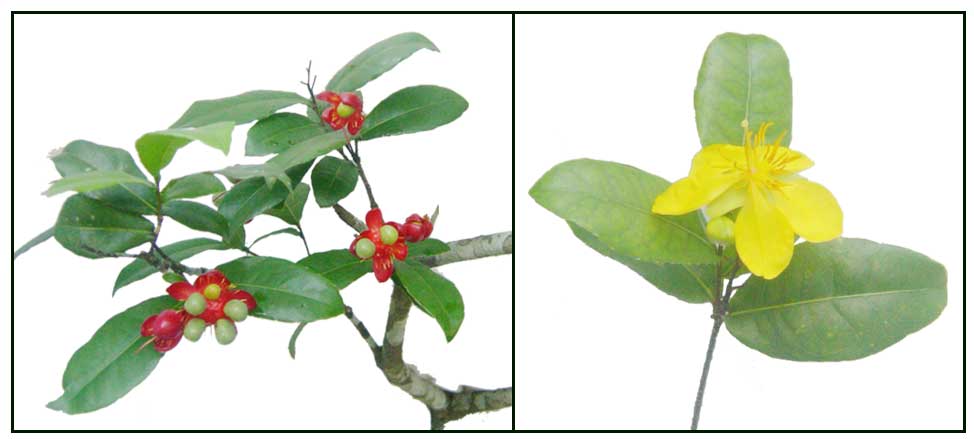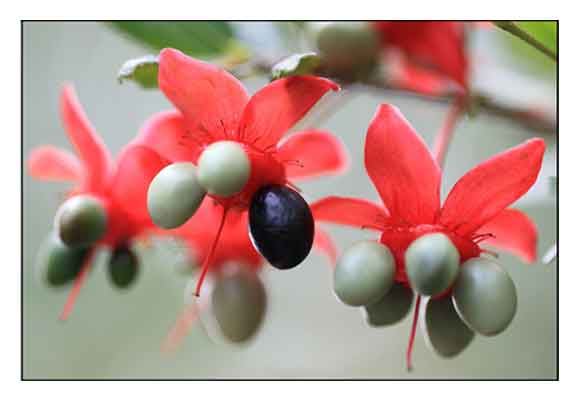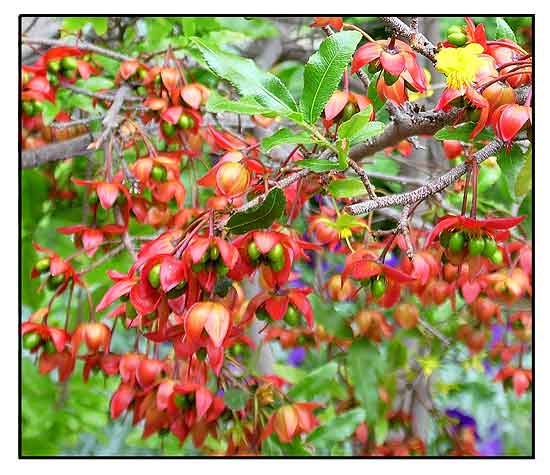
Gen info
- Ochna kirkii, from the family Ochnaceae, is one of the 86 species of Ochna shrub and trees. It is similar to Ochna serrulata, also called Mickey Mouse plant, which has smaller and serrated leaves and smaller flowers; O. kirkii, in comparison, has larger and rounder leaves and larger flowers.
- The genus name Ochna comes from the Greek work Ochne, meaning "wild pear" because of its similarity to leaves of the pear tree. The species epithet honors Thomas Kirk, a writer on New Zealand plants.
- O. kirkii was named for Sir John Kirk (1832-1922), a Scottish physician, naturalist, explorer and diplomat or Thomas Kirk, a writer on New Zealand plants.
- The common name, Mickey Mouse Plant, derives from the clusters of dark fruitlets surrounded by red sepals, supplemented by red stamens, which somewhat resembles the Walt Disney cartoon character.
 Botany Botany
Ochna kirkii is a big shrub or small tree growing to
a height of 3 to 4.5 meters tall. Leaves are glossy and dark green, alternate,
oblong-elliptic to narrow-obovate, cuneate or heart-shaped, blunt or
rounded at the tip, up to 10 centimeters long, margins are entire or undulate,
usually with fine hairs. Flowers are in small panicles or short , lateral
branchlets. Petals are 2.5 centimeters long, calyx is red. Fruit is are black, rounded and glossy, protruding from the swollen base of bright red calyx, resembling Mickey Mouse ears when paired.
Distribution
- Native to southeastern Africa.
-
Introduced to the
Philippines after WWII.
- Native to Kenya, Mozambique, Tanzania. (2)
- Cultivated for its colorful flowers.
-
Used as hedge plant.
 Constituents Constituents
- Study of stem and root bark extracts of Ochna thomasiana yielded lophirone A, afzelone D dimethylether, calodenone, a mixture of stigmasterol and β-sitosterol and 3β-acetyl-24-ethylfriedelane. Roots yielded biflavonoids and sterols. (see study below) (3)
- Phytochemical quantification study yielded total ash 5.15% ±0.4623, acid insoluble ash 0.32%
± 0.6214, water soluble ash 10.72% ± 0.2340, alcohol soluble extractive 12.8% ± 1.3370, ether soluble extractives 7.30% ± 1.8341, water content 5.76% ± 0.0040, loss on drying 6.91% ± 2.6133. (4)
- Preliminary phytochemical screening of leaves yielded flavonoids, tannins, phenols, saponins, and triterpenoid.
Total phenolic content was 252.08 mg GAE/g ± 0.4430. (4)
- Study of methanolic extract of root bark isolated the new isoflavonoid kirkinone A (1) and biflavonoid kirkinone B (2) along with six known compounds (3-8) (see study below) (6)
Parts used
Roots, branches, leaves.
Uses
Folkloric
- Decoction of roots, branches
and leaves used for wound healing.
- In Thailand, root used for diarrhea and
hallucination.
- In Mozambique, used for the treatment of malaria. Cold maceration of roots and leaves used for the treatment of diarrhea, cough and headache. (5)
Studies
• Antibacterial / Stem and Root Bark: Study evaluated the biologic activities of Ochna thomasiana. Stem and root bark methanol crude extracts showed high activity against Gram-positive bacteria viz., E. coli, B. subtilis, S. aureus with 14, 15, and 20 mm zones of inhibition, respectively. (3)
• Antibacterial / Cytotoxic / Biflavonoids / Root Bark: Study of methanolic extract of root bark isolated the new isoflavonoid kirkinone A (1) and biflavonoid kirkinone B (2) along with six known compounds (3-8) Calodenin B (4) and lophirone A(6) showed significant antibacterial activity against Gram-positive bacteria Bacillus subtilis with MIC values of 2.2 and 28 µM, and cytotoxicty against MCF-7 human breast cancer cell line with IC50 of 219.3 and19.2 µM, respectively. (6)
Availability
- Wildcrafted.
- Cultivated.
|







